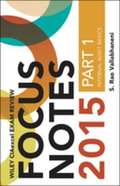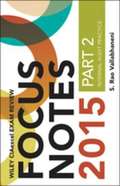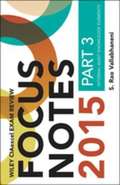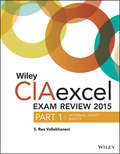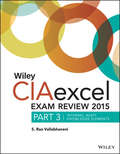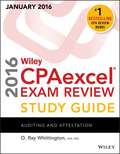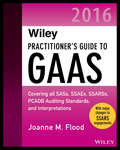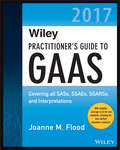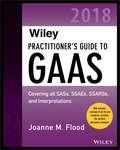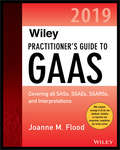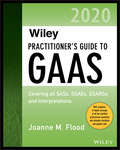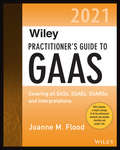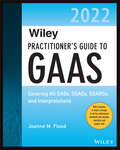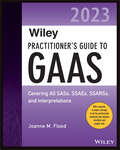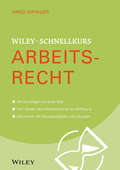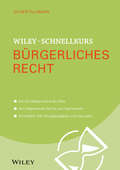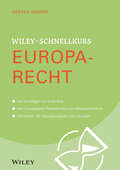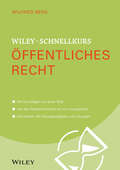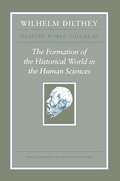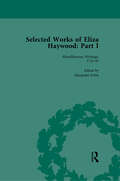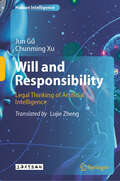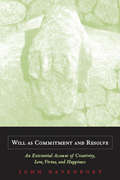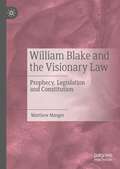- Table View
- List View
Wiley CIAexcel Exam Review 2014 Focus Notes
by S. Rao VallabhaneniDrive home your knowledge, skills, and abilities for the 2014 CIA ExamStudy for the CIA Exam to develop mastery of the knowledge, skills, and abilities you'll be tested on with Wiley CIA Exam Review 2014 Focus Notes, Part 1. Developed to be a precise, easy-to-use resource, this study guide covers Internal Audit Basics and is organized in the same manner as the Wiley CIA Exam Review topics. Use the portable, spiral-bound, flashcard format to study anywhere you go and to quickly and efficiently grasp the vast knowledge base associated with the exam.Expert author S. Rao Vallabhaneni puts his twenty-five years of internal auditing and accounting management experience to work to bring you hundreds of outlines, summarized concepts, and useful techniques to help hone your CIA Exam knowledge and pass the test your first time out.
Wiley CIAexcel Exam Review 2015 Focus Notes, Part 1
by S. Rao VallabhaneniThe Wiley CIA Exam Review Focus Notes are developed for each of the three parts of the Certified Internal Auditor (CIA) exam sponsored by the Institute of Internal Auditors (IIA). The purpose of the focus notes is to digest and assimilate the vast amounts of knowledge, skills, and abilities (KSAs) tested on the CIA exam in a clear, concise, easy-to-read, and easy-to-use format. Each of the focus notes book topics is organized in the same way as the Wiley CIA Exam Review book topics, that is, one focus-notes book for each of the four-volume review books. The four-volume Focus Notes books will supplement and complement the existing Wiley CIA Exam Review books.
Wiley CIAexcel Exam Review 2015 Focus Notes, Part 2
by S. Rao VallabhaneniThe Wiley CIA Exam Review Focus Notes are developed for each of the three parts of the Certified Internal Auditor (CIA) exam sponsored by the Institute of Internal Auditors (IIA). The purpose of the focus notes is to digest and assimilate the vast amounts of knowledge, skills, and abilities (KSAs) tested on the CIA exam in a clear, concise, easy-to-read, and easy-to-use format. Each of the focus notes book topics is organized in the same way as the Wiley CIA Exam Review book topics, that is, one focus-notes book for each of the four-volume review books. The four-volume Focus Notes books will supplement and complement the existing Wiley CIA Exam Review books.
Wiley CIAexcel Exam Review 2015 Focus Notes, Part 3
by S. Rao VallabhaneniDrive home your knowledge, skills, and abilities for the 2014 CIA Exam Study for the CIA Exam to develop mastery of the knowledge, skills, and abilities you'll be tested on with Wiley CIA Exam Review 2014 Focus Notes, Part 3. Developed to be a precise, easy-to-use resource, this study guide covers Internal Audit Knowledge Elements and is organized in the same manner as the Wiley CIA Exam Review topics. Use the portable, spiral-bound, flashcard format to study anywhere you go and to quickly and efficiently grasp the vast knowledge base associated with the exam. Expert author S. Rao Vallabhaneni puts his twenty-five years of internal auditing and accounting management experience to work to bring you hundreds of outlines, summarized concepts, and useful techniques to help hone your CIA Exam knowledge and pass the test your first time out.
Wiley CIAexcel Exam Review 2015, Part 1
by S. Rao VallabhaneniThe CIA exam tests a candidate's knowledge of current internal auditing practices and understanding of internal audit issues, risks, and remedies. Volume 1: Internal Audit Process corresponds to Part I of the CIA exam, The Internal Audit Activity's Role in Governance, Risk, and Control. Wiley CIA Exam Review, Volume 1 covers : How to comply with the IIA's attribute standardsEstablishing a risk-based plan to determine the priorities of the internal audit activityThe internal audit activity's role in organizational governancePerforming other internal audit roles and responsibilitiesGovernance, risk and control knowledge elementsAudit engagement planning.
Wiley CIAexcel Exam Review 2015, Part 2
by S. Rao VallabhaneniThe CIA exam tests a candidate's knowledge of current internal auditing practices and understanding of internal audit issues, risks, and remedies. Volume 2: Internal Audit Skills corresponds to Part II of the CIA exam, Conducting the Internal Audit Engagement. Wiley CIA Exam Review, Volume 2 covers:Conducting engagementsCarrying out specific engagementsMonitoring engagement outcomesFraud knowledge elementsEngagement tools.
Wiley Cpaexcel Exam Review 2016 Study Guide January: Auditing And Attestation
by O. Ray WhittingtonThe Wiley CPAexcel Study Guides have helped over a half million candidates pass the CPA Exam. This volume contains all current AICPA content requirements in Auditing and Attestation (AUD). The comprehensive four-volume paperback set (AUD, BEC, FAR, REG) reviews all four parts of the CPA Exam. With 3,800 multiple-choice questions. The CPA study guides provide the detailed information candidates need to master or reinforce tough topic areas. The content is separated into 48 modules. Unique modular format--helps candidates zero in on areas that need work, organize their study program, and concentrate their efforts. Comprehensive questions--over 3,800 multiple-choice questions and their solutions in the complete set (AUD, BEC, FAR, REG). Guidelines, pointers, and tips show how to build knowledge in a logical and reinforcing way. Arms test-takers with detailed text explanations and skill-building problems to help candidates identify, focus on, and master the specific topics that may need additional reinforcement. Available in print format.
Wiley Practitioner's Guide to GAAS 2016: Covering all SASs, SSAEs, SSARSs, PCAOB Auditing Standards, and Interpretations
by Joanne M. FloodPlain-English interpretations and applications of the latest GAAS Wiley Practitioner's Guide to GAAS 2016 provides full guidance toward the latest guidelines and applications of Generally Accepted Auditing Standards. With detailed coverage of the newest releases, this helpful reference explains each standard in clear, accessible language and highlights the ways in which the standards are related. Organized for easy navigation, each statement is presented individually along with explanation, practice notes, practical illustrations, checklists and questionnaires to guide you through the auditing process. The book is written to align with the Statements on Auditing Standards, and includes updates and interpretations of all new Statements for Accounting and Review Services Compilation and Review statements to help you ensure a complete and fully compliant audit. Accounting standards are critical to the auditing process, but frequent revisions and new releases add a layer of complexity to compliance. This book provides interpretation and application notes for all GAAS standards, including all SASs, SSAEs, SSARSs and PCAOB. Get up to speed on the latest GAAS standards Walk through each statement step-by-step Utilize helpful tools to ensure full compliance Gain a deeper understanding of each standard's applications Identifying, interpreting, and applying the many standards relevant to a particular engagement can be the most difficult part of the auditor's job. This guide simplifies the process by combining the standards, explanations, tools, and expert advice into a single, easily navigated volume. For the auditor who needs to be up to date, Wiley Practitioner's Guide to GAAS 2016 presents clear, plain-language guidance toward the most recent GAAS standards, to help you find --and understand -- the answers you need quickly.
Wiley Practitioner's Guide to GAAS 2017: Covering all SASs, SSAEs, SSARSs, and Interpretations
by Joanne M. FloodThe clearest, easiest-to-use guide to understanding all the clarified standards, including the new attestation standards—fully updated! This comprehensive guide to understanding Generally Accepted Auditing Standards (GAAS) is not just about auditing. It addresses the toughest part of an accountant's job—identifying, interpreting, and applying the many audit, attest, review, compilation, and preparation standards relevant to a particular engagement. Wiley Practitioner's Guide to GAAS 2017 offers a clear and accessible distillation of the official language of GAAS, Statements on Standards for Attestation Engagements (SSAEs), and Statements on Standards for Accounting and Review Services (SSARSs)—as well as advice on exactly how to remain fully compliant with each. Wiley Practitioner's Guide to GAAS 2017 is organized according to the logical arrangement of the clarified standards, presenting each section individually, and explaining how it is related to the engagement process. Guidance is offered on the entire process, in the form of practice notes, checklists, questionnaires, and real-world examples, illustrating how the fundamental requirements of each section are applied. Other key features include: A brief identification of each auditing, SSAE, and SSARS section, with effective dates and tips on how to apply it Highlights of new requirements in the clarified attestation standards Concise listing and descriptions of each section's specific mandates, including definitions Easy-to-read capsule summary of interpretations, plus selected technical alerts Helpful techniques for remaining compliant with each standard New in GAAS 2017: In 2016, the AICPA's Auditing Standards Board completed a major stage of its clarity project and issued SSAE No. 18. The new guidance is effective for reports dated May 1, 2017. SSAE No. 18 replaces the attestation standards, introducing major new requirements that will change practice. In this transition year, guidance on the extant attestation standards is also included. Wiley Practitioner's Guide to GAAS 2017 is completely updated to reflect all the clarified standards and provide valuable implementation information.
Wiley Practitioner's Guide to GAAS 2018: Covering all SASs, SSAEs, SSARSs, PCAOB Auditing Standards, and Interpretations (Wiley Regulatory Reporting)
by Joanne M. FloodThe clearest, easiest-to-use guide to understanding all the clarified standards, including the new attestation standards—fully updated! This comprehensive guide to understanding Generally Accepted Auditing Standards (GAAS) is not just about auditing. It addresses the toughest part of an accountant's job—identifying, interpreting, and applying the many audit, attest, review, compilation, and preparation standards relevant to a particular engagement. Wiley Practitioner's Guide to GAAS 2018 offers a clear and accessible distillation of the official language of GAAS, Statements on Standards for Attestation Engagements (SSAEs), and Statements on Standards for Accounting and Review Services (SSARSs)—as well as advice on exactly how to remain fully compliant with each. Wiley Practitioner's Guide to GAAS 2018 is organized according to the logical arrangement of the clarified standards, presenting each section individually, and explaining how it is related to the engagement process. Guidance is offered on the entire process, in the form of practice notes, checklists, questionnaires, and real-world examples, illustrating how the fundamental requirements of each section are applied. Other key features include: A brief identification of each auditing, SSAE, and SSARS section, with effective dates and tips on how to apply it Highlights of new requirements in the clarified attestation standards Concise listing and descriptions of each section's specific mandates, including definitions Easy-to-read capsule summary of interpretations, plus selected technical alerts Helpful techniques for remaining compliant with each standard
Wiley Practitioner's Guide to GAAS 2019: Covering all SASs, SSAEs, SSARSs, PCAOB Auditing Standards, and Interpretations (Wiley Regulatory Reporting)
by Joanne M. FloodThe definitive reference for clarified standards application and compliance, fully updated for 2019 The Wiley Practitioner's Guide to GAAS 2019 is the comprehensive and user-friendly guide to Generally Accepted Auditing Standards. Fully updated to reflect all new standards, practices, and statements—including Statements on Standards for Accounting and Review Services (SSARS) and Statements on Standards for Attestation Engagements (SSAE)—this essential resource offers practitioners a clear and complete reference in a single volume. This book provides complete coverage of relevant areas including audit planning and documentation, audit evaluation and evidence, examination and review engagements, and more to help auditors interpret and apply current auditing standards while maintaining full compliance with GAAS. General auditing standards are subject to frequent updates and divergent interpretations, yet practitioners need to keep pace with the latest changes if compliance is to be maintained. Employing a logical organizational structure, this guide defines and interprets each clarified standard and explains its relation to the engagement process. Practice notes, checklists, questionnaires, and relevant real-world examples demonstrate how each section is applied. This indispensable resource provides in-depth guidance on GAAS interpretation, application, and compliance to help you: Identify and apply each auditing, SSAE and SSARS section Understand new requirements in clarified attestation standards Access technical alerts, interpretation summaries, and individual section descriptions and definitions Employ techniques to maintain compliance with each standard TheWiley Practitioner's Guide to GAAS 2019 provides auditing professionals with the expert guidance and up-to-date information necessary to save you time, streamline your workload, and maximize your job performance.
Wiley Practitioner's Guide to GAAS 2020: Covering all SASs, SSAEs, SSARSs, and Interpretations (Wiley Regulatory Reporting #101)
by Joanne M. FloodA comprehensive guide to GAAS for 2020, covering critical auditing standards, practices, and procedures Over the last few years, the AICPA has clarified all its professional standards, raising challenges for the accounting professional to stay current and in compliance. This edition will give auditors and accountants the knowledge and understanding they will need to competently perform and successfully complete their engagements. With this valuable resource, readers will have a comprehensive guide to the latest professional standards, practices, and procedures. The Wiley Practitioner's Guide to GAAS 2020 provides an analysis of all SASs, SSAEs, SSARSs, and Interpretations. This one book provides all the most recent revisions to the standards, explaining them in a clear way that’s designed for greater understanding. Whenever standards are changed, professionals need guidance on conducting engagements efficiently and effectively. This guide to GAAS and other professional standards provides helpful, systematic direction that saves auditors and accountants time and supports them in their jobs. Readers will have a comprehensive view of moving through the process of auditing, reviewing, compiling, and preparing financial statements and performing attestation services. In addition to explanations, readers will get a detailed discussion of current issues and gain the benefits of practice notes, illustrations, checklists, and questionnaires to reference. Practitioners will find: Organization based on the way auditors use the Statements on Auditing Standards, ensuring efficiency and ease of navigation Comprehensive guidance through the auditing process Explanations of all attestation standards Updates and interpretations of Statements on Standards for Accounting and Review Services The Wiley Practitioner's Guide to GAAS 2020 is a fully updated resource for completing audit, attestation, review, compilation, and preparation engagements successfully.
Wiley Practitioner's Guide to GAAS 2021: Covering all SASs, SSAEs, SSARSs, and Interpretations (Wiley Regulatory Reporting)
by Joanne M. FloodA comprehensive guide to GAAS for 2021, covering critical auditing standards, practices, and procedures Over the last few years, the AICPA has clarified all its professional standards, raising challenges for the accounting professional to stay current and in compliance. This edition will give auditors and accountants the knowledge and understanding they will need to competently perform and successfully complete their engagements. With this valuable resource, readers will have a comprehensive guide to the latest professional standards, practices, and procedures. The Wiley Practitioner's Guide to GAAS 2021 provides an analysis of all SASs, SSAEs, SSARSs, and Interpretations. This one book provides all the most recent revisions to the standards, explaining them in a clear way that's designed for greater understanding. Whenever standards are changed, professionals need guidance on conducting engagements efficiently and effectively. This guide to GAAS and other professional standards provides helpful, systematic direction that saves auditors and accountants time and supports them in their jobs. Readers will have a comprehensive view of moving through the process of auditing, reviewing, compiling, and preparing financial statements and performing attestation services. In addition to explanations, readers will get a detailed discussion of current issues and gain the benefits of practice notes, illustrations, checklists, and questionnaires to reference. Practitioners will find: Organization based on the way auditors use the Statements on Auditing Standards, ensuring efficiency and ease of navigation Comprehensive guidance through the auditing process Explanations of all attestation standards Updates and interpretations of Statements on Standards for Accounting and Review Services The Wiley Practitioner's Guide to GAAS 2021 is a fully updated resource for completing audit, attestation, review, compilation, and preparation engagements successfully.
Wiley Practitioner's Guide to GAAS 2022: Covering All SASs, SSAEs, SSARSs, and Interpretations (Wiley Regulatory Reporting)
by Joanne M. FloodThe most comprehensive and up-to-date guide to critical auditing standards, practices, and procedures for 2022The American Institute of Certified Public Accountants (AICPA) sets the Generally Accepted Auditing Standards or GAAS under which U. S. audits are conducted in the United States. Auditors must comply with and understand every aspect of GAAS in order to comply with AICPA standards. As a result, it is crucial for CPAs to be up-to-date on all applicable guidelines, rules, and regulations.Wiley Practitioner’s Guide to GAAS 2022 delivers a thorough description and analysis of not only auditing standards – SASs, but also SSAEs, SSARSs, and the Interpretations necessary to fully understand all the latest professional standards. The guide offers the most recent revisions to the standards, including those on: Materiality, Audit reports, ERISA audits, SSAE direct examination engagements, and Practitioner’s review reports. The Guide explains the standards clearly and accurately, providing explicit information on how to conduct your engagements efficiently, effectively, and properly—all in one resource. In addition, Wiley Practitioner’s Guide to GAAS 2022 provides readers with: Practical direction on the steps necessary to help you comply with GAAS Comprehensive guidance on the entire auditing process, from start to finish Explanations of all attestation and review, compilation, and preparation standards A glossary of relevant terminology for each subject A crucial resource for accountants and auditors who are looking for a comprehensive explanation of the information used on a daily basis, Wiley Practitioner’s Guide to GAAS 2022 is an invaluable resource written to save you time and simplify your compliance with professional standards. The most comprehensive and up-to-date guide to critical auditing standards, practices, and procedures for 2022
Wiley Practitioner's Guide to GAAS 2023: Covering All SASs, SSAEs, SSARSs, and Interpretations (Wiley Regulatory Reporting)
by Joanne M. FloodThe most comprehensive and up-to-date guide to critical auditing standards, practices, and procedures for 2023 The American Institute of Certified Public Accountants (AICPA) sets the Generally Accepted Auditing Standards—or GAAS—under which U. S. audits are conducted. Auditors must comply with and understand every aspect of GAAS to comply with AICPA standards. As a result, it is crucial for CPAs to be up to date on all applicable guidelines, rules, and regulations. Wiley Practitioner’s Guide to GAAS 2023 delivers a thorough description and analysis of not only auditing standards—SASs—but also SSAEs, SSARSs, and the Interpretations necessary to fully understand all the latest professional standards. The 2023 Guide offers the most recent revisions to the standards, including those on: Audit evidence Auditing accounting estimates Use of pricing evidence Inquiries of predecessor auditors Quality management Materiality, SSAE direct examination engagements, and Practitioner’s review reports. Practical direction on the steps necessary to help you comply with GAAS Comprehensive guidance on the entire auditing process, from start to finish Explanations of all attestation and review, compilation, and preparation standards A glossary of relevant terminology for each subjectIt explains the standards clearly and accurately, providing explicit information on how to conduct your engagements efficiently, effectively, and properly—all in one resource. In addition, Wiley Practitioner’s Guide to GAAS 2023 provides readers with: A crucial resource for accountants and auditors who are looking for a comprehensive explanation of the information used daily, Wiley Practitioner’s Guide to GAAS 2023 is an invaluable resource written to save you time and simplify your compliance with professional standards.
Wiley-Schnellkurs Arbeitsrecht (Wiley Schnellkurs)
by Arnd DiringerWer wissen will, wie ein Unternehmen funktioniert, sollte sich auch im Arbeitsrecht auskennen. Deshalb ist es Teil vieler Studiengänge jenseits der Rechtswissenschaften. Häufig haben diese Studenten Probleme mit dem Fach, aber Hilfe naht. Arnd Diringer erklärt Ihnen in diesem Buch auf den Punkt gebracht, was Sie über Arbeitsrecht wissen sollten. Er erläutert die wichtigsten Punkte von Begriffen und Systematik des Arbeitsrechts, über Anbahnung eines Arbeitsverhältnisses, Rechte und Pflichten von Arbeitnehmern bis zur Beendigung einer Tätigkeit. Mit vielen Beispielen und Übungsfragen können Sie Ihr frisch erworbenes Wissen testen und festigen und so ist dieses Buch eine gute Hilfe für Sie, wenn Sie schnell und nicht allzu tief in das Arbeitsrecht einsteigen wollen.
Wiley-Schnellkurs Bürgerliches Recht (Wiley Schnellkurs)
by Oliver TillmannIm Studium kommen Sie am Bürgerlichen Recht kaum vorbei und das zu Recht: Es ist eben nunmal wichtig. Oliver Tillmann erklärt Ihnen die Systematik des BGB und was Sie zum Allgemeinen Teil wissen sollten. Hier erfahren Sie, das Wichtigste zu Willenserklärungen, Verträge, Stellvertretung, Rechts- und Geschäftsfähigkeit. Außerdem führt er Sie in das Schuldrecht und das Sachenrecht ein. Kursorisch streift er gegen Ende des Buches auch noch das Familien- und Erbrecht. Zahlreiche Übungsaufgaben mit Lösungen helfen Ihnen, Ihr Wissen zu testen und zu festigen.
Wiley-Schnellkurs Europarecht (Wiley Schnellkurs)
by Gerald SanderEuroparecht beschäftigt sich mit den rechtlichen Grundlagen der Europäischen Union. Gerald Sander liefert Ihnen einen schnellen à berblick über die Organe der EU wie das Europäische Pralament, die Europäische Kommission und die EZB. Auà erdem erläutert er, welche Rechtsquellen das Europarecht hat, welche Verfahren es gibt, was es mit der Wirtschafts- und Währungsunion auf sich hat und vieles mehr. Mit à bungsaufgaben mit Lösungen können Sie sich selbst testen und Ihr Wissen festigen.
Wiley-Schnellkurs Öffentliches Recht (Wiley Schnellkurs)
by Wilfried BergDieses Buch hilft Ihnen, wenn Sie schon immer wissen wollten oder für eine Prüfung wissenmüssen, wie die Bundesrepublik von Rechts wegen her funktioniert. Wilfried Berg erklärt Ihnen, was Sie über Verfassung und Verwaltungsrecht wissen sollten. Das geht von den Funktionen der Staatsorgane,über die Grundrechte bis zum Verwaltungsverfahren. Kapitel zum Verwaltungsprozessrecht, wie auch zur Europäischen Union runden das Buch ab. So ist das Buch eine schnelle Hilfe für Sie, wenn Sie sich einen Überblick über unser Staatswesen verschaffen wollen.
Wilhelm Dilthey: The Formation of the Historical World in the Human Sciences
by Wilhelm DiltheyThis volume provides Dilthey's most mature and best formulation of his Critique of Historical Reason. It begins with three "Studies Toward the Foundation of the Human Sciences," in which Dilthey refashions Husserlian concepts to describe the basic structures of consciousness relevant to historical understanding.The volume next presents the major 1910 work The Formation of the Historical World in the Human Sciences. Here Dilthey considers the degree to which carriers of history--individuals, cultures, institutions, and communities--can be articulated as productive systems capable of generating value and meaning and of realizing purposes. Hegel's idea of objective spirit is reconceived in a more empirical form to designate the medium of commonality in which historical beings are immersed. Any universal claims about history need to be framed within the specific productive systems analyzed by the various human sciences. Dilthey's drafts for the Continuation of the Formation contain extensive discussions of the categories most important for our knowledge of historical life: meaning, value, purpose, time, and development. He also examines the contributions of autobiography to historical understanding and of biography to scientific history.The finest summary of Dilthey's views on hermeneutics can be found in "The Understanding of Other Persons and Their Manifestations of Life." Here, Dilthey differentiates understanding relative to three kinds of manifestations of life. After giving his analysis of elementary understanding, he examines the role of induction in higher understanding and interpretation, and the relevance of transposition and re-experiencing for grasping individuality.
Will Sustainability Fly?: Aviation Fuel Options in a Low-Carbon World
by Walter J. PalmerWhile international negotiations to reduce greenhouse gas (GHG) emissions have been less than satisfactory, there is a presumption that a significant level of multi-lateral commitment will be realized at some point. International air and marine travel have been left to one side in past talks because the pursuit of agreement proceeds on the basis of commitment by sovereign nations and the effects of these specific commercial activities are, by their nature, difficult to corral and assign to specific national jurisdictions. However, air travel is increasing and, unless something is done, emissions from this segment of our world economy will form a progressively larger percentage of the total, especially as emissions fall in other activities. This book focuses on fuel. The aim is to provide background in technical and policy terms, from the broadest reliable sources of information available, for the necessary discourse on society's reaction to the evolving aviation emissions profile. It considers what policy has been, why and how commercial air travel is committed to its current liquid fuel, how that fuel can be made without using fossil-source materials, and the barriers to change. It also advances some elements of policy remedies that make sense in providing an environmentally and economically sound way forward in a context that comprehends a more complete vision of sustainability than 'renewable fuels' traditionally have. The goal of Will Sustainability Fly? is to broaden and contextualize the knowledge resource available to academics, policy makers, air industry leaders and stakeholders, and interested members of the public.
Will Sustainability Fly?: Aviation Fuel Options in a Low-Carbon World
by Walter J. PalmerWhile international negotiations to reduce greenhouse gas (GHG) emissions have been less than satisfactory, there is a presumption that a significant level of multi-lateral commitment will be realized at some point. International air and marine travel have been left to one side in past talks because the pursuit of agreement proceeds on the basis of commitment by sovereign nations and the effects of these specific commercial activities are, by their nature, difficult to corral and assign to specific national jurisdictions. However, air travel is increasing and, unless something is done, emissions from this segment of our world economy will form a progressively larger percentage of the total, especially as emissions fall in other activities. This book focuses on fuel. The aim is to provide background in technical and policy terms, from the broadest reliable sources of information available, for the necessary discourse on society's reaction to the evolving aviation emissions profile. It considers what policy has been, why and how commercial air travel is committed to its current liquid fuel, how that fuel can be made without using fossil-source materials, and the barriers to change. It also advances some elements of policy remedies that make sense in providing an environmentally and economically sound way forward in a context that comprehends a more complete vision of sustainability than 'renewable fuels' traditionally have. The goal of Will Sustainability Fly? is to broaden and contextualize the knowledge resource available to academics, policy makers, air industry leaders and stakeholders, and interested members of the public.
Will and Responsibility: Legal Thinking of Artificial Intelligence (Human Intelligence)
by Chunming Xu Jun GuThis book explores the authors' legal thinking on artificial intelligence (AI), a topic of burgeoning interest in the technology sector and among the general public. As part of the Human Intelligence book series, it primarily addresses the legislative and philosophical challenges posed by AI technology. A key philosophical concern discussed is the implications of AI surpassing human intelligence in certain domains, particularly the definition of rights and responsibilities for robots. Without clear resolutions to these issues, the deployment of AI technology may face significant hurdles. The book covers various aspects, including the legal recognition of robots as rights-holders, strategies for implementing these rights, assigning responsibilities to robots, intellectual property rights for robotic inventions, personality rights for companion robots, and an evaluation of the pros and cons of a binary legal system.
Will as Commitment and Resolve: An Existential Account of Creativity, Love, Virtue, and Happiness
by John J. DavenportIn contemporary philosophy, the will is often regarded as a sheer philosophical fiction. In Will as Commitment and Resolve, Davenport argues not only that the will is the central power of human agency that makes decisions and forms intentions but also that it includes the capacity to generate new motivation different in structure from prepurposive desires. The concept of "projective motivation" is the central innovation in Davenport's existential account of the everyday notion of striving will. Beginning with the contrast between "eastern" and "western" attitudes toward assertive willing, Davenport traces the lineage of the idea of projective motivation from NeoPlatonic and Christian conceptions of divine motivation to Scotus, Kant, Marx, Arendt, and Levinas. Rich with historical detail, this book includes an extended examination of Platonic and Aristotelian eudaimonist theories of human motivation. Drawing on contemporary critiques of egoism, Davenport argues that happiness is primarily a byproduct of activities and pursuits aimed at other agent-transcending goods for their own sake. In particular, the motives in virtues and in the practices as defined by Alasdair MacIntyre are projective rather than eudaimonist. This theory is supported by analyses of radical evil, accounts of intrinsic motivation in existential psychology, and contemporary theories of identity-forming commitment in analytic moral psychology. Following Viktor Frankl, Joseph Raz, and others, Davenport argues that Harry Frankfurt's conception of caring requires objective values worth caring about, which serve as rational grounds for projecting new final ends. The argument concludes with a taxonomy of values or goods, devotion to which can make life meaningful for us.
William Blake and the Visionary Law: Prophecy, Legislation and Constitution
by Matthew MaugerThis book examines the difficult relationship between individual intellectual freedom and the legal structures which govern human societies in William Blake’s works, showing that this tension carries a political urgency that has not yet been recognised by scholars in the field. In doing so, it offers a new approach to Blake’s corpus that builds on the literary and cultural historical work of recent decades. Blake’s pronouncements about law may often sound biblical in tone; but this book argues that they directly address (and are informed by) eighteenth-century legal debates concerning the origin of the English common law, the autonomy of the judicature, the increasing legislative role of Parliament, and the emergence of the notions of constitutionalism and natural rights. Through a study of his illuminated books, manuscript works, notebook drafts and annotations, this study considers Blake’s understanding that law is both integral to humanity itself and a core component of its potential fulfilment of the ‘Human Form Divine’.

